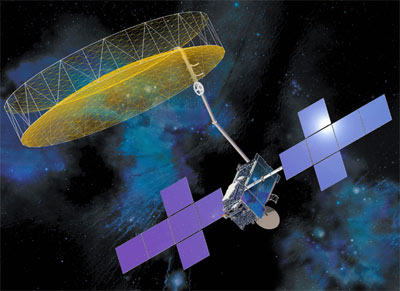Inmarsat + SkyTerra = Spectrum Sharing
Posted by samc on December 26th, 2007SkyTerra and Inmarsat have reached a major pact to offer L-band hybrid mobile satellite services in North America, reports RCR News.
 “We have worked long and hard with Inmarsat to develop this agreement, which sets operational parameters in the L-band for existing satellite operations and lays the groundwork for future cooperation to address consumers’ demand for next generation technology and services,” said Alexander Good, CEO of SkyTerra and vice chairman of MSV.
“We have worked long and hard with Inmarsat to develop this agreement, which sets operational parameters in the L-band for existing satellite operations and lays the groundwork for future cooperation to address consumers’ demand for next generation technology and services,” said Alexander Good, CEO of SkyTerra and vice chairman of MSV.
The cooperative-coordination agreement, among other things, includes a provision for the re-banding of satellite spectrum over North America to permit contiguous spectrum for MSS services with ATC (ground repeater) authorization.
Some elements of the cooperative agreement are subject to approval by the FCC and the State Department, as well as coordination with other governments. The companies said the agreement also establishes a structure whereby Inmarsat will modify its North American operations to allow MSV to make more extensive use of L-Band spectrum.
Other MSS licensees such as Globalstar, ICO and TerreStar Networks may need to offer similar competitive offerings, say analysts. They expect U.S. officials to sign off on the SkyTerra-MSV-Inmarsat agreement.
 Inmarsat’s BGAN, with satellites over the Atlantic, Indian and (soon) Pacific oceans, can provide direct-to-satellite connections at speeds up to 492kbps to laptop-size terminals.
Inmarsat’s BGAN, with satellites over the Atlantic, Indian and (soon) Pacific oceans, can provide direct-to-satellite connections at speeds up to 492kbps to laptop-size terminals.
SkyTerra-MSV plans a similar spot-beam satellite service over North America, providing voice and data to small hand-held phones. Their Ancillary Terrestrial Component (ATC), acts as a repeater for the geosynchronous satellites, provide coverage inside automobiles, residences and urban or rural canyons, where satellite coverage is normally blocked.
The two new MSV satellites, under construction by The Boeing Company, will operate in geostationary orbit in the L-Band (1.6 GHz) over North America from 101 degrees and 107.3 degrees west longitude. The satellites feature 22-meter diameter, elliptical mesh reflectors that will support L-band communication with conventional handsets through a network based on MSV’s patented ancillary terrestrial component technology.
TerreStar Networks hopes to launch North America’s first next-generation mobile satellite service using the MSS band (at 2 GHz) next year. It will provide universal access throughout North America with a first-to-market launch strategy in 2008. TerreStar plans to provide other communications carriers and the U.S. government with access to its network, which the company plans to roll-out in late 2008 or early 2009.
Most satellite phones, like low earth orbit Iridium and Globalstar operate in the 1616 - 1626.5 MHz region of the L-Band.
The U.S. FCC also authorized two new mobile satellite services (MSS) systems in the 2 GHz band to provide service in the United States. They will be Terrestar and Craig McCaw’s ICO. ICO’s first GEO satellite is scheduled to be launched in early 2008. It features a 12-meter reflector that focuses the 2 GHz signals on North America and should be launched in March 2008. Thuraya 3, which covers the middle east, transmits and receives calls through a single 40-foot antenna using 250-300 spot beams to provide mobile telephone services that are compatible with dual-mode GSM phones.





No comments:
Post a Comment